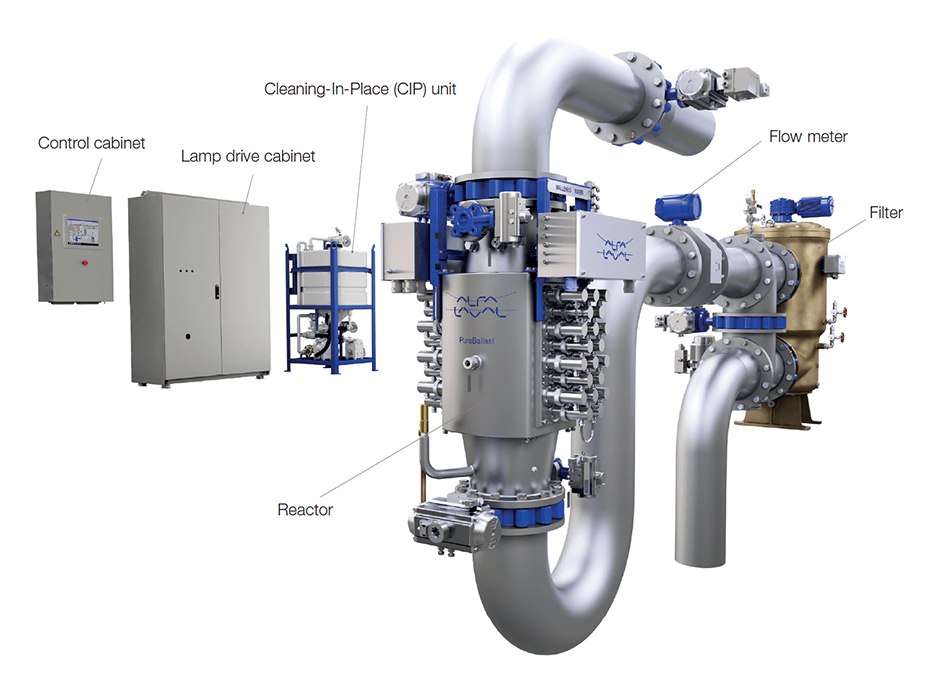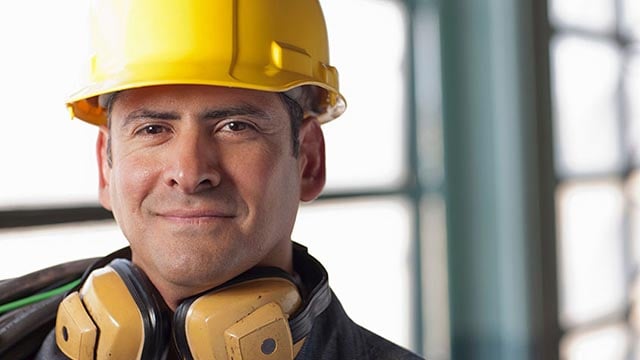
PureBallast 3 combines initial filtration with enhanced UV treatment in a specially designed reactor.
The main treatment process, occurs within an enhanced UV reactor. The reactor has a flow-optimized interior that ensures high turbulence and the concentration of the UV dose.
The medium-pressure UV lamps within the reactor employ specially designed lamp sleeves of synthetic quartz. These unique sleeves support transmission of a broader wavelength spectrum and provide more UV light during disinfection. Combined with the reactor’s internal design, this ensures optimal UV dosage and low energy consumption.
Supporting the reactor is a filter stage, used to remove any larger organisms and particles prior to biological disinfection. This improves the quality of water for treatment, especially when operating in cloudy coastal waters and fresh water.
In combination with the reactor, the effective basket filter design enables full-flow treatment of fresh, brackish and marine water with UV transmittance as low as 42%.
The fully automated system ballasting process, when starting, it undergoes a brief start-up sequence. When ballasting begins, the incoming ballast water first passes through the filter stage. This removes any larger organisms and particles, which improves the quality of the water for treatment. The filter stage is of benefit for operation in cloudy coastal waters and fresh water. After filtration the water continues through the reactor stage, where it is disinfected by means of enhanced UV before entering the ballast water tanks.
Once ballasting is complete, reactor cleaning is performed via an automatic Cleaning-In-Place (CIP) cycle. This cycle is prompted immediately after ballasting and should be performed within 30 hours. The reactor stage is rinsed with fresh water when the CIP cycle begins and filled with fresh water upon its completion. The filter stage is also filled with fresh water once ballasting is completed. The same start-up and shutdown sequence, including CIP, is employed during both ballasting and deballasting.
The deballasting process is the same as the ballasting process. However, the filter stage is bypassed during deballasting since the water has already been filtered. After leaving the ballast water tanks, the outgoing ballast water passes through the reactor stage to eliminate any regrowth of microorganisms that may have occurred in transit. Having thus been disinfected to the established limits, it is discharged into the receiving water at the deballasting site.
Once ballasting is complete, reactor cleaning is performed via an automatic Cleaning-In-Place (CIP) cycle. This cycle is prompted immediately after ballasting and should be performed within 30 hours. The reactor stage is rinsed with fresh water when the CIP cycle begins and filled with fresh water upon its completion. The filter stage is also filled with fresh water once ballasting is completed. The same start-up and shutdown sequence, including CIP, is employed during both ballasting and deballasting.
For ballast water flows of 85–300 m3/h PureBallast 3 Compact is a convenient, skid-mounted solution for smaller ballast water flows. Installation is easy due to the small footprint and minimized pipework.
-Skid-mounted, plug-and-play module
-Flexibly placed electrical cabinet
For ballast water flows of 85–1000 m3/h PureBallast 3 Compact Flex is the ideal choice for most vessels. Delivered as loose components, it maximizes space savings and installation flexibility.
-Complete installation freedom
-Minimized system footprint
For ballast water flows of 250–3000 m3/h PureBallast 3 Std provides the widest range of reactor configurations and technical opportunities on vessels with non-hazardous environments.
-Maximum range of operation and component placement
-Up to 6000 m3/h with dual systems
For ballast water flows of 250–3000 m3/h PureBallast 3 Ex gives vessels with explosive environments redundant safety features and high flexibility. The power supply can be placed outside the hazardous zone.
-ATEX and IECEx, Zone 1, IIC and T4
-Up to 6000 m3/h with dual systems
PureBallast 3 Ex systems are available for flows of 250–3000 m3/h, with dual systems providing coverage for up to 6000 m3/h. They can be supplied in range of Ex configurations according to ATEX and IECEx, Zone 1, IIC and T4. Design is simplified by the flexible placement of the lamp drive cabinets, which can be located outside the hazardous zone and up to 150 m away from the reactors they serve.
Redundant safety features, such as the connection of the reactor temperature and level sensors via relays that bypass the PLC, increase safety in operation.

The technical teams for Alfa Laval ballast water treatment systems and Framo pumping systems have developed a solution for providing additional pumping head when PureBallast 3 Ex is installed in a deckhouse. By ensuring that the PureBallast 3 Ex system can handle its own pressure requirements, the optional booster pump unit (BPU) removes the need for changes in the existing ballast pumping system, thereby retaining its optimization and the vessel’s cargo offloading rates
If your vessel is a tanker, ATEX requirements might not be your only issue. If you use submersible cargo pumps, you probably don’t have a pump room or much other space for a ballast water treatment system. Fortunately, Alfa Laval can provide a deckhouse, so that you can install topside. More than just a container, a deckhouse is a protective, insulated solution – with an integrated booster pump option, to help out if your existing ballast water pumps aren’t strong enough.
If your vessel is a bulker, you probably load cargo at twice the rate you unload it. If so, you deballast at twice the speed of ballasting. That gives you an opportunity to save. A PureBallast 3 bulker-fit configuration adjusts the UV reactor and filter capacities, so that you install only what a bulker needs for compliance. Not only does it create a smaller system footprint, it also lowers your investment and operating costs.
PureBallast 3 documentation for shipyards and other installing parties is divided into:
Direct assistance from Alfa Laval is also available to aid design and planning, as well as in the installation and commissioning processes.
Download Alfa Laval’s ballast water management resources to learn more about PureBallast 3 and how it compares to other available treatment technologies. To obtain design and installation documentation or more information, please contact Alfa Laval.